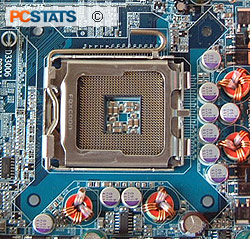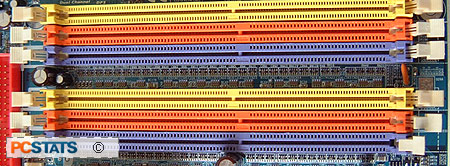 With the release of
the LGA775 Pentium 4 processor also came a pair of brand new motherboard
chipsets. This was exciting news for a number of reasons; Intel has generally
been on the cutting edge in terms of introducing new features into their
chipsets as they become available, and these two new products were no exception.
With the release of
the LGA775 Pentium 4 processor also came a pair of brand new motherboard
chipsets. This was exciting news for a number of reasons; Intel has generally
been on the cutting edge in terms of introducing new features into their
chipsets as they become available, and these two new products were no exception.
With the release of the 915P and 925X chipsets, computer
enthusiasts were first able to get their hands on consumer level PCI Express
enabled motherboards. As you know, PCI Express is the technology that is
replacing the now aging AGP slot (if you don't know, check out our comprehensive
PCI Express technology article here). ATI and nVidia and their licensees have already
released several PCI Express compatible video cards, and it is inevitable that
the technology will have completely supplanted AGP by the end of this year.
Aside from carrying video data, PCI Express also
presents a considerable upgrade over the capabilities of the standard PCI
expansion slot, enabling easy support for applications like gigabit Ethernet.
Essentially, PCI Express allows for more high-bandwidth connections in your PC,
both internally and externally, opening the gateway to future improvements.
A second new technology that was first seen on these new
Intel chipsets is DDR2 memory. This next generation of the DDR (Double Data
Rate) memory standard allows memory makers to ramp up the frequency of the
memory to keep up with the demands of new processors as they are released.
This is more of an incremental upgrade than a brand new
technology, but it is an essential step, since DDR memory has pretty much
reached its maximum performance ceiling at the PC-3200 (DDR-400) speed.  See
PCSTATS DDR2 article here for more info. Both the 915P/925X chipsets support
up to 4GB of DDR/DDR-2 memory.
See
PCSTATS DDR2 article here for more info. Both the 915P/925X chipsets support
up to 4GB of DDR/DDR-2 memory.
The third feature that grabbed our interest when the
chipsets were released is the ICH-6 Southbridge. The ICH-6 represents a
considerable step forward from the previous ICH5 Intel Southbridge.
The Southbridge chip is an IC that handles the various
I/O subsystems on the motherboard, like the PCI bus, IDE and Serial ATA for hard
drives, USB, etc. It organizes the information that is to be sent to or received
from these devices and communicates with the Northbridge chip which in turn
talks to the processor and memory.
Both of these chipsets should eventually be ported to
the new BTX motherboard form factor at some point
in their active life, but right now things are a little confusing on this point.
It appears that most developers are sticking with ATX for now, but may begin
instituting a requirement for a new power supply since PCI Express peripherals
in general and video cards in particular require so much power. Expect to buy a
new 24-pin power supply of at least 400 Watts to go with your next new Intel
board and processor.
We'll explore some of the above features in more detail
later in the article. First let's take a look at the specifics of the two new
chipsets, starting with the 915.
